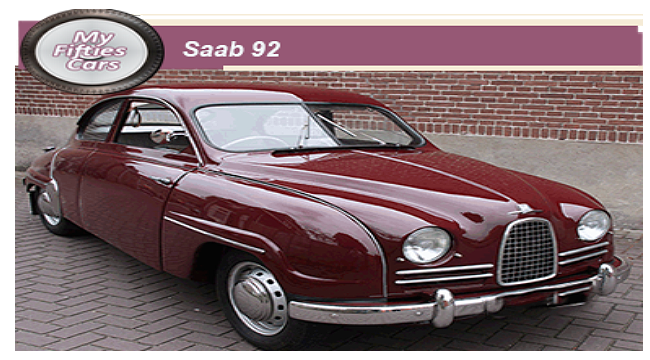
Like their Swedish counterparts, Volvo, Saab, or Svenska Aeroplan AB—SAAB initially produced aircraft for civilian as well as military use.
H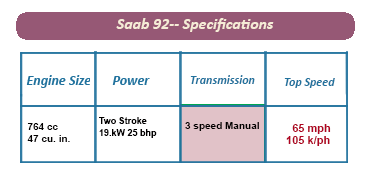 aving had to live in the shadow of their Swedish counterparts for so many years has been a daunting task and Saab had held their own through building cars that were as tough as they were elegant.
aving had to live in the shadow of their Swedish counterparts for so many years has been a daunting task and Saab had held their own through building cars that were as tough as they were elegant.
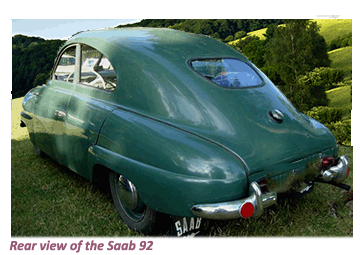 Fearing that orders for new aircraft would be sparse after the Second World War2 11, -branched out into making cars with the Model 92.
Fearing that orders for new aircraft would be sparse after the Second World War2 11, -branched out into making cars with the Model 92.
The 92 was Saab's first production car, designed to flout all of the current conventional engineering and design principles, looking like no other car on the market in the early Fifties.
Powered by a two-cylinder two-Stroke 46-cubic-inch (764-cc) engine put out a maximum 25 bhp (19 kW).with tight-alloy head and hemispherical combustion chambers, the 92 was far from of the mark but sturdy and reliable to meet the challenges of the demanding Swedish winters.
 The car's teardrop styling was sleek, futuristic, and highly aerodynamic for the time, with a drag coefficient of only 0.30. It also had an integral safety cage to protect occupants in an accident, which made this one of the first cars designed with safety in mind.
The car's teardrop styling was sleek, futuristic, and highly aerodynamic for the time, with a drag coefficient of only 0.30. It also had an integral safety cage to protect occupants in an accident, which made this one of the first cars designed with safety in mind.
![]()
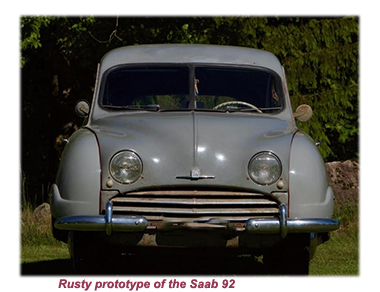
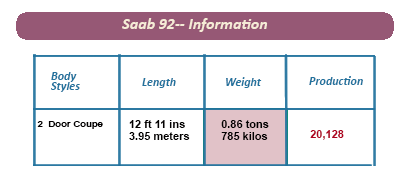 Early Saabs had independent torsion-bar suspension all around, as well as a flat floor-pan and rack-and-pinion steering. The low placement of back-seat passengers allowed the fastback shape, with low drag coefficient that would become a Saab trademark well into the Sixties
Early Saabs had independent torsion-bar suspension all around, as well as a flat floor-pan and rack-and-pinion steering. The low placement of back-seat passengers allowed the fastback shape, with low drag coefficient that would become a Saab trademark well into the Sixties
 To help cut costs. Saab used a back window smaller than planned and omitted a trunk lid, allowing the petrol filler cap to go below the back window, while a vertical back panel held the tail lamps and license plate. Doors were hinged at the rear, which sometimes made entry a cumbersome process, and was not to every owner's liking.
That continuous roofline stretched from the windshield all the way to the tail end, with large triangular side windows following that profile. A smooth body line also ran from the bottom of the front to the rear.
To help cut costs. Saab used a back window smaller than planned and omitted a trunk lid, allowing the petrol filler cap to go below the back window, while a vertical back panel held the tail lamps and license plate. Doors were hinged at the rear, which sometimes made entry a cumbersome process, and was not to every owner's liking.
That continuous roofline stretched from the windshield all the way to the tail end, with large triangular side windows following that profile. A smooth body line also ran from the bottom of the front to the rear.
![]()
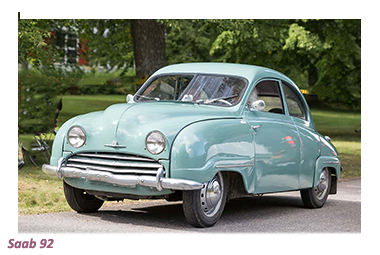 The Saab 92's façade was dominated by a low, shallow grille opening contained four horizontal bars, with a Saab badge above, while along the hood sat a small central spine.
The Saab 92's façade was dominated by a low, shallow grille opening contained four horizontal bars, with a Saab badge above, while along the hood sat a small central spine.
Small round parking lights sat below and outboard of the 92's headlamps, while Semaphore-style turn signals were mounted high on center pillars.
The seats were all covered in strong cloth upholstery while of the car's instruments, including an up- to- the minute strip-style speedometer, sat in a long rectangular panel, ahead of the driver, with an open glove box to the right and a rear-view mirror atop the dashboard.
Deluxe models were fitted with such luxuries as a clock and temperature gauge, plus a rear center armrest and extra horn.
 In 1954 the Saab 92 was handed almost a complete mechanical makeover, enough to see it maintain its niche in the market until it was replaced by the 93 in 1956.
In 1954 the Saab 92 was handed almost a complete mechanical makeover, enough to see it maintain its niche in the market until it was replaced by the 93 in 1956.
The first Saab had hardly set the heather on fire in terms of critical approval or sales, but had played a major part in establishing a foothold in the market for the company in Scandinavia and later for most of Western Europe.


